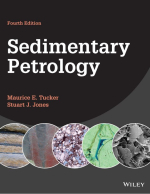Добрый день, Коллеги. Важное сообщение, просьба принять участие. Музей Ферсмана ищет помощь для реставрационных работ в помещении. Подробности по ссылке
Sedimentary petrology / Петрология осадочных пород
Some 75% of the rocks at the Earth’s surface are sedimentary in origin, and these include the familiar sandstones, limestones and shales, and the less common but equally well-known salt deposits, ironstones, coal and chert. Sedimentary rocks of the geological record were deposited in the whole range of natural environments that exist today. The study of these modern environments and their sediments and processes contributes much to the understanding of their ancient equivalents. There are some sedimentary rock types; however, for which there are no known modern analogues, or their inferred depositional environments are only poorly represented at the present time.
Once deposited, sediments are subjected to the processes of diagenesis, that is physical, chemical and biological processes which bring about compaction, cementation, recrystallisation and other modifications to the original sediment, to form rocks.
There are many reasons for studying sedimentary rocks, not least because of their importance as aquifers for groundwater and the wealth of economic minerals and materials contained within them. The fossil fuels oil and gas are derived from the maturation of organic matter in sediments and these then migrate to suitable reservoirs, mostly porous sedimentary rocks. The other fossil fuel, coal, is also contained within sedimentary sequences of course. Sedimentary rocks supply much of the world’s iron, potash, salt, building materials and many, many other essential raw materials. Sedimentological and petrological techniques are increasingly used in the search for new reserves of these fuels and other natural resources. As the transition to a low-carbon economy gains pace, the importance of sedimentary petrology is being realised for the storage of CO2 in sandstone reservoirs where injecting CO2 often promotes geochemical reactions and diagenesis. Exploring deep aquifers to act as potential sources of geothermal energy requires sedimentary rocks with appropriate porosity and permeability distributions at depth, such that the natural heat flow in the Earth’s subsurface allows water present in pore spaces within the rock to be heated to temperatures suitable for the production of hot water back to the surface via wells.
Non-biodegradable plastics and microplastics are accumulating in sediments across all depositional environments globally and process-based sedimentology is important to assess their distribution and burial. The growing awareness of the environmental pollution caused by plastics from rivers to deep-marine environments needs quantitative detailed approaches using sedimentology and petrology to fully constrain their impact and better understand how that can be mitigated.Environments and processes of deposition, palaeogeography and palaeoclimatology, can all be deduced from studies of sedimentary rocks. Such studies contribute much towards a knowledge and understanding of the Earth’s geological history. Sedimentary rocks contain the record of life on Earth (and extraterrestrial), in the form of fossils, and these are the principal means of stratigraphic correlation in the Phanerozoic. <...>




